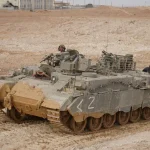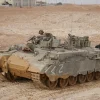Israel’s “Narrow Waist”
When the War of Independence broke out in 1947, the Jewish community of Hebron fled. During the fighting, nine Jewish communities were captured by the Jordanian army – Kibbutz Beit Ha’arava and Kaliya north of the Dead Sea, four kibbutzim in Gush Etzion west of Bethlehem, Atarot and Neve Yaakov north of Jerusalem, and the Jewish Quarter of its Old City. Kfar Darom, in the Gaza strip, was captured by the Egyptian army.
Read More






